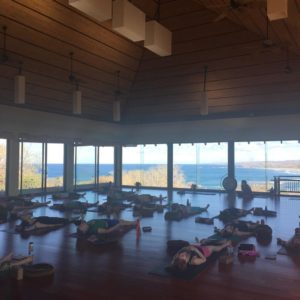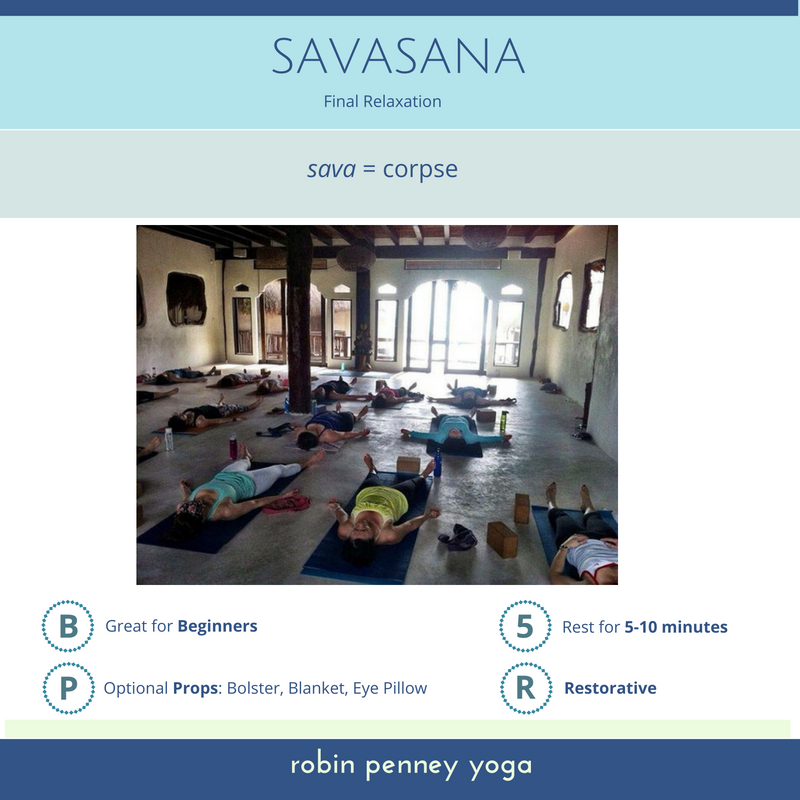6 Reasons Not To Skimp on Savasana (+tips for teachers and at-home yogis)

Savasana. How sweet it is. No matter what we each experience during an asana practice, we all rest here, often with cozy blankets and supportive props. It’s a super sweet way to end a class, especially if we’ve really challenged ourselves.
But there is a pattern emerging in both studio classes and online classes of skimping on Savasana…of shortening up the final relaxation so we only get 1-2 minutes, or even as little as 5 breaths to rest. As teachers, we are trying to pack a lot into 60 or 75-minute classes, and it’s hard to give up the extra postures we want to squeeze in without sacrificing the time in Savasana. And if you’re practicing at home, it is tempting to just get up after your practice and get on with your life, especially if an online teacher gives you an out.
Savasana is known as the most important posture in yoga. Why are we skimping? Here’s why you shouldn’t cut your final relaxation short, and how to make sure you get the most of it.
1. Savasana relieves physical fatigue
BKS Iyengar says in Light on Yoga, “After completing the practice of asanas always lie down in Savasana for at least 10 to 15 minutes, as this will remove fatigue. Gradually, when the nerves become passive, one feels completely relaxed and refreshed. In good relaxation one feels energy flow from the back of the head towards the heels and not the other way around. One also feels as if the body is elongated.”
Now, don’t get too hung up on the 10-15 minute suggestion. Remember that Mr. Iyengar was normally practicing for upwards of 2 hours at a time. A good guideline is to rest for about 5 minutes for every 60 minutes of asana practice.
Resting after a vigorous practice will let your muscles release any remaining tension, so you feel rejuvenated after your practice. It gives your body time to integrate and balance out before leaping back into life. And with the energy moving out of the head and downward, it helps us really chill and get grounded.
2. Beyond the muscles, Savasana allows your organs to process toxins and destress
In the Summer of 2016, I attended a workshop on yoga’s effect on neuroplasticity (the brain’s ability to change throughout one’s life, not just during childhood) with yoga teacher Tiffany Cruikshank. Tiffany talked about how regular relaxation can have a positive effect, even on our ORGANS.
Engaging regularly in things like Ujayi breath, work with the diaphragm, focus on the exhalation, pranayama (breath practices) and relaxation (Savasana) can actually change neurons and pathways, and shift us into the parasympathetic nervous system (PNS). When we’re in a state of PNS activation, our body gets to rest, repair, and digest. If we are always “stuck” in the sympathetic nervous system, these body processes get postponed, which can lead to chronic stress.
Simple things we do regularly are more powerful than big things we do every now and then. Make a longer Savasana a habit in your yoga practice, and it will pay off.
There is tremendous value in taking the time to activate the PNS using techniques like relaxation in Savasana. What a great way to care for your body.
3. Savasana is the best cure for modern-day stress
Beyond the body, there is the mind. “To tame Prana depends on the nerves. Steady, smooth, fine, and deep breathing without any jerky movements of the body soothes the nerves and calms the mind. The stresses of modern civilization are a strain on the nerves for which Savasana is the best antidote.” – BKS Iyengar, Light on Yoga
Light on Yoga was first published in 1966, but this statement is surely true today, especially when we have so many more ways to distract ourselves from being alone…with ourselves (think devices and media…it’s easy to let yourself be engulfed in your phone rather than sit quietly). At a certain point, we cannot escape ourselves and Savasana is a good way to practice this skill without distraction.
Mr. Iyengar says, “it is much harder to keep the mind than the body still. Therefore, this apparently easy posture is one of the most difficult to master. By remaining motionless for some time and keeping the mind still while you are fully conscious, you learn to relax. This conscious relaxation invigorates and refreshes both body and mind.”
Just as an arm balance takes steady practice and discipline over time, so does saying present in Savasana. And giving yourself more than a couple of minutes will help train the muscle of awareness.
4. Savasana helps you practice letting things go
Ever composed a to-do list in your head during Savasana? We tend to start moving on to the next part of the day when class starts to wind down. How about this definition of Savasana…sound familiar?
“Savasana, in my mind, translated from the Sanskrit to roughly “time to lie around and obsess about things left undone – or things done I wish I could change.” Schuyler Grant, Yoga Teacher
Yep, I can relate.
I practiced Moksha Yoga for about a year, and one thing I really liked about that series was the “mini Savasana” that comes in the middle of the practice. It’s only about 1 minute long. The goal: how quickly can you drop everything – your roles, your personality, the practice you’ve done up to that point, everything. This struck me as a really useful practice. To drop things. To let them go.
Sometimes it’s easier to drop things and let go when you’re in the peace of a serene yoga studio and a teacher is gently guiding you through a long Savasana. But I also encourage you to practice this on your own at home. Set a timer for 5 minutes and just see how much you can let go. Doing these practices in the middle of your home life, where there are likely to be distractions (pets, kids, doorbells, noises, etc.), is a good way to get better at letting go of things in the rest of your life so you can move on.
5. Savasana trains you to watch patterns and learn to shift them
Become interested in watching where your energy is going as you rest in Savasana. This is a little bit subtle, so I’ll give you an example. See, I tend to be a little narcoleptic…I can fall asleep anywhere…and in Savasana and also meditation, I can drift off quite easily, especially when I’m physically exhausted. Then when I wake up, I get a little angry with myself and beat myself up because I’m “supposed to be” alert and fully conscious.
One of my teachers, Manorama, encouraged me recently to “watch the prana” (vital energy) when this happens. So I’ve been really paying attention to where the energy is moving and what it’s doing. If I feel myself falling asleep, and when I get frustrated with myself, I try to not “spend my prana on that anger.” Instead, I try to accumulate the prana so I can use it for something else in my life. To stay vital.
I invite you to watch patterns in your own body and mind and really dig down deep with them. See where they lead you, and what you can shift and transform, and how you can increase your vitality by using and storing the energy as it moves. Try it, and see what happens.
6. Savasana invites you to more fully embrace life, every time
Savasana literally means “corpse pose.” Morbid, right? What it really symbolizes is the death of the ego and the promise of awakening to an enlightened state of consciousness.
Yoga philosophy teaches us that illusion (“maya”) causes us to believe we will live forever. We don’t often contemplate death and what it means. In the book Myths of the Asanas, the chapter on Savasana points out, “We often do not think about our impending death. The yoga tradition suggests that it would be wise to consider it, because it gives us a sense of purpose that can inspire us to make good use of the time we have on earth.”
The book goes on to tell the story of a king who is cursed to die in 7 days. The king uses his last 7 days of life to learn about the science of the soul and to meditate on yoga with sages. What would you do if you knew you only had seven days left to live?
Schuyler Grant echoes these thoughts in the book, Wanderlust: “In a culture that closets aging and death within hospitals and institutions, how poignant to make practicing death a sacred part of your day. And that the emergence out of the pose, every time, represents the possibility of a more keenly observed and cherished life. I occasionally taste the nectar of yoga during corpse pose – the unification of my consciousness, the merging of my individual limitation, with something greater than myself. Don’t underestimate the power of those last ten minutes of class. Every time you practice savasana or teach savasana, you might ask, “When I die, what do I want to be able to say about how I lived?”

Tips for Teachers and At-Home Yogis
If you feel like you need to extend or adjust your Savasana practice, here are some practical tips for making sure you allow time and space for restoration and transformation, each time you finish practicing or teaching the active part of practice:
- A good rule of thumb: 5 minutes for every hour of practice. So for a 75-minute class, plan on 7 minutes.
- Just one minute of pranayama (breath work) right before Savasana can have a profound effect on the quality of Savasana.
- Teachers, beginning and ending class on time shows respect for your students and what they have planned after yoga. We always have control over when a class ends, and Savasana is a partner in making that happen.
- Use a timer – I like a 6-minute Savasana for home practice. If I’m practicing at home with the guidance of a yoga video, I will set my own timer for Savasana. Many online teachers will offer very short Savasanas (as little as a few breaths) so as to offer flexibility for the home practitioner, but you can always extend that on your own! A good timer app that I like is the Insight Timer.
- If you like music during Savasana, try a 50/50 approach. Play music for half the time, and then transition to silence. It is a good practice to rest in silence.
- As a teacher, be mindful of your energy during Savasana. Use it as a time to be present in your own awareness. One of my fellow teachers told me once that she silently offers each student acknowledgment and gratitude for their presence during Savasana. Lovely, right?
How long is your Savasana, and what’s it like? Where would you like to shift it? I’d love to hear about it!

 Empowering women who are 40+ to install movement habits that are nourishing, strengthening, and approachable for a truly calm and connected life.
Empowering women who are 40+ to install movement habits that are nourishing, strengthening, and approachable for a truly calm and connected life.